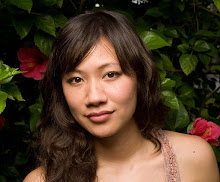---
Nearly all Cambodians (or Khmers), young and old, don a linen checked scarf. More for function than style, the krama can be used as a shield from dust, heat, as a sweat rag, sling, anything and everything. This notion is not new as I’ve seen and bought similar rags through Southeast Asia for similar reasons.
While in Phnom Penh, the country’s capital, I visit S-21 (Tuol Sleng Museum), a school turned torture and detention center. I then make a jaunt to the Choeung Ek Killing Fields, where millions of Cambodians – men, women, children of all backgrounds -- were cruelly killed. A beautiful stupa serves as a memorial housing some 9,000 skulls. The victims’ faded, ragged clothing are piled on bottom shelf including kramas. At S-21, many photos of detainees are displayed. A few are smiling, almost all are stoic, solemn. I notice some have a krama encircling their necks. I read that those very scarves were also used to choke, suffocate, and silence the screams during the killings.
The reality is that Cambodia is still terribly impoverished. Begging at every corner is expected; tuk tuk drivers make $10 a day if they’re lucky. Eating insects or anything edible is normal. Toddlers run around half naked, and the clothes they do have look so grimy especially due to the prevalent red dirt. No amount of bleach and detergent can rid of it (I know.) Bargaining is no longer fun, because as quickly as you can say, “too expensive”, the sellers immediately drop the price by half. I sense honest desperation.
Despite these conditions and circumstances, Cambodians seem genuinely happy and are overwhelmingly friendly towards each other and to tourists alike. The people, the towns, and the ambience is so chill, you forget and enjoy yourself easily. Before I reached Phnom Penh, I relaxed at Sihanoukville’s Serendipity beach and Bamboo Island. Throughout the country, I must have waved and returned hellos to almost every enthusiastic Cambodian child under age 10. Undoubtedly, I come away like many visitors, confounded by the apparent disparity of a startling not-so-distant past and the cheery face of Cambodia today.
My time in this country has ended, but I will continue wearing my krama. For me and Cambodians too, the scarf is a powerful symbol that speaks to their identity -- and for me, their complicated past. Such a simple accessory represents a tragic history. But, it is a visible link to their ancestors, and a reminder to never forget.
If you are unfamiliar with the Khmer Rouge and the genocide, I strongly recommend that you read about it. Or consider watching a Cambodian documentary, Enemies of the People, which I had the honor of viewing in Cambodia at the invitation of expat law students. (They are working as interns during the trials of the Khmer Rouge leaders.) In the film, a Cambodian journalist, whose family died in the Killing Fields, interviews the killers including Khmer Rouge leader, Nuon Chea -- a ten-year project in his spare time.
Or, visit Cambodia, contribute the economy, and see for yourself. It is a little rough around the edges, but it's scenic and adventurous, and as aforementioned, the people are beautiful and extremely open.

Inside the memorial stupa at Choeung Ek Killing Fields

Detention rooms at Tuol Sleng Museum or S-21

Millions of civilians' were forced to leave their homes and towns and into labor camps. More than two million civilian deaths occurred between '75 to '79.

A classroom turned detention facility. Once upon a time, a school, but later used for torturing before civilians were sent to the Killing Fields.

A view of the boat trip from Siem Reap, home of Angkor Wat.

Inside Angkor Wat

The many faces of Angkor Thom temple

Ta Prohm temple, which was used in Tomb Raider

A view of Battambang, the second largest city

Me and my krama



































